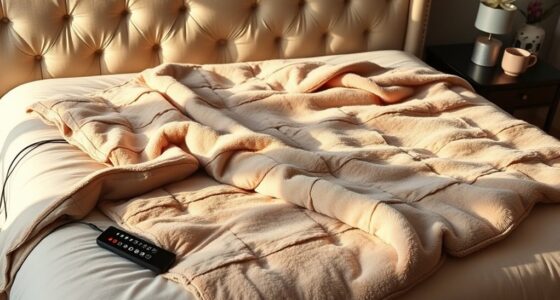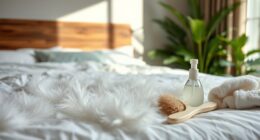Featherbeds have a fascinating history, tracing back to the 14th century as symbols of luxury and status among the wealthy. These cherished items feature soft down, offering pressure relief and excellent temperature regulation for a restful sleep. They also carry cultural significance, often passed down as heirlooms and included in wedding dowries. Today, innovations in design enhance their comfort, and sustainable materials offer eco-friendly choices. Discover more about their enduring appeal and the benefits they bring.
Key Takeaways
- Featherbeds originated in the 14th century, symbolizing luxury and status, often passed down through generations as cherished heirlooms.
- They evolved from early designs focused on softness to modern innovations emphasizing support, breathability, and customized comfort.
- Health benefits include excellent temperature regulation, hypoallergenic properties, and pressure relief for improved spinal alignment during sleep.
- The bedding market is influenced by economic factors, with fluctuating demand impacting featherbed prices and availability.
- Sustainable alternatives, such as hemp and Lyocell, offer eco-friendly options that promote healthier sleep environments and reduce environmental impact.
The Origins of Featherbeds: A Symbol of Luxury
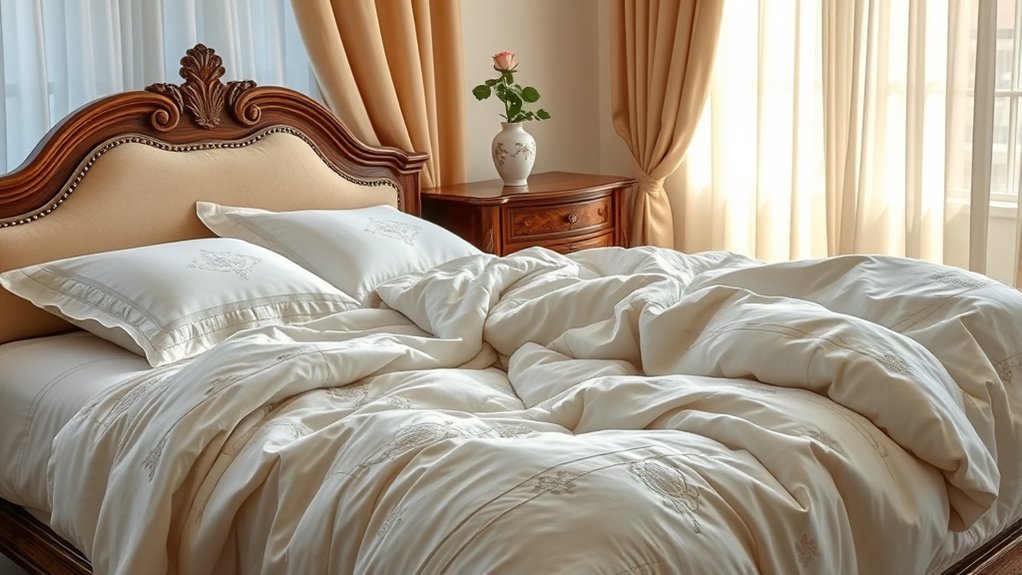
Although featherbeds are now appreciated for their comfort, they originally symbolized luxury and status among the wealthy. In the 14th century, only the affluent could afford these lavish items, filled with prized feathers from geese or ducks. Beds may have headboards crafted using tightly woven linen or cotton, these featherbeds became valuable possessions, often passed down through generations or included in wills. The high-quality materials and craftsmanship used in their production enhanced their durability, making them cherished family heirlooms. Additionally, the use of natural materials like wood and linen in their construction reflects a timeless commitment to quality and comfort. Modern adjustments to home heating, such as heat pump technology, can further enhance the cozy atmosphere that featherbeds provide. Furthermore, the incorporation of natural elements in bedding design not only elevates aesthetic appeal but also contributes to a calming sleep environment.
During the medieval period, most beds were simple and lacked comfort, but the emergence of featherbeds marked a significant shift. As they became more accessible in the 19th century, their luxurious reputation remained. Owning a featherbed wasn’t just about comfort; it represented prosperity and a respectable household, making them essential for newlyweds and significant life events.
The Evolution of Design: Innovations in Comfort
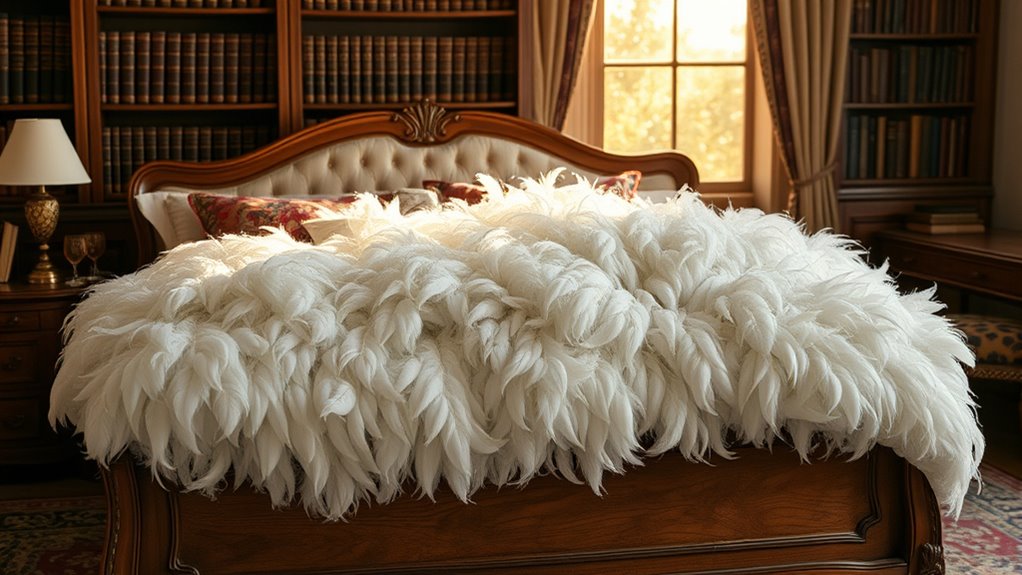
As the quest for comfort evolved, featherbeds underwent significant transformations that enhanced their appeal and functionality. Early designs featuring down feathers offered unmatched softness, while the 19th-century introduction of innerspring mattresses improved support. The incorporation of high-quality materials in their construction has further elevated the comfort and durability of modern featherbeds. Additionally, the use of cozy textiles in bedding design has contributed to an inviting sleep environment. Furthermore, advancements in energy efficiency have influenced the development of sustainable bedding options, promoting eco-friendly practices in the industry. The rise of renewable energy has also encouraged manufacturers to adopt more sustainable production methods.
Timber frames with latticework provided a sturdy foundation for these luxurious bedding options, particularly during the Victorian era when featherbeds became symbols of wealth and opulence. The development of the Featherbed frame in the motorcycle industry also showcases how innovative design can lead to improved performance and comfort.
Modern advances have taken comfort to new heights, incorporating materials like memory foam for better pressure relief and support. Innovations in design now focus on breathability and customized features, ensuring that your featherbed not only feels good but also aligns with your personal comfort preferences. This evolution reflects a continuous pursuit of the perfect sleep experience.
Health Benefits: Why Featherbeds Enhance Sleep Quality
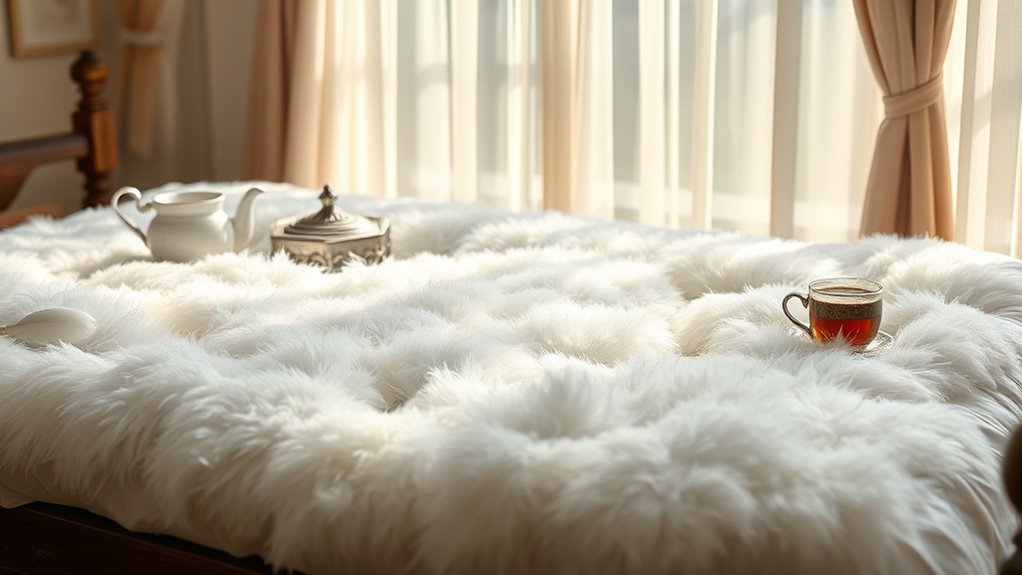
Featherbeds not only reflect the evolution of design but also offer significant health benefits that enhance your sleep quality. They excel in temperature regulation, allowing for better airflow and preventing heat buildup, creating a comfortable sleep environment. Their hypoallergenic properties help resist allergens like dust mites and pollen, promoting a healthier sleep space. The softness of feathers relieves pressure points, aligning your spine and reducing discomfort. Featherbeds are breathable, maintaining a consistent body temperature and encouraging deeper, restorative sleep. Plus, they’re durable, retaining their fluffy support over time. Additionally, the natural materials used in featherbeds contribute to a truly relaxing bedtime routine. Ultimately, the luxurious feel of a featherbed enhances relaxation, making it easier for you to fall asleep and stay asleep, improving both your physical and mental well-being. Furthermore, studies suggest that proper sleep quality is essential for overall health and well-being, as existential themes in sleep research indicate that enhanced rest can lead to improved decision-making and emotional resilience.
Cultural Significance: Traditions and Heirlooms
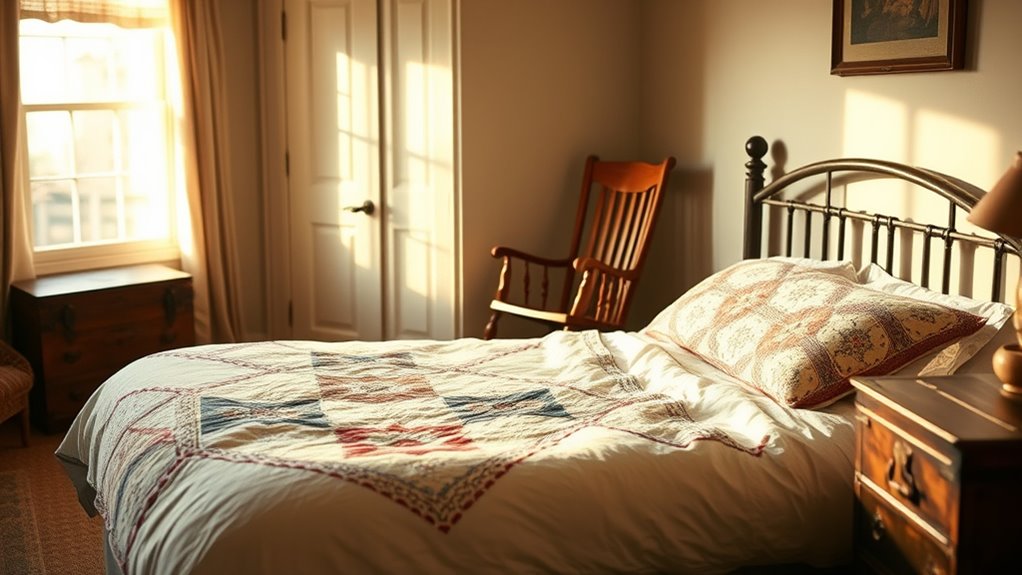
While many sleep on modern mattresses, the cultural significance of featherbeds as treasured traditions and heirlooms remains strong. Once a luxury for the wealthy, featherbeds evolved into symbols of family legacy, often passed down through generations. You might find that your grandmother’s featherbed holds stories of your family’s history, serving as both comfort and connection. In various cultures, these beds are included in wedding dowries, signifying new beginnings, and during family gatherings, they promote unity. People meticulously saved feathers over time, showing dedication to comfort. By preserving and restoring featherbeds, you maintain not just a physical object but a tangible link to your heritage, reinforcing the emotional ties that bind your family together. Additionally, the cultural roles of feather boas in Indigenous traditions highlight how objects made from feathers carry significant meaning and community ties.
Economic Factors: Accessibility and Production Growth
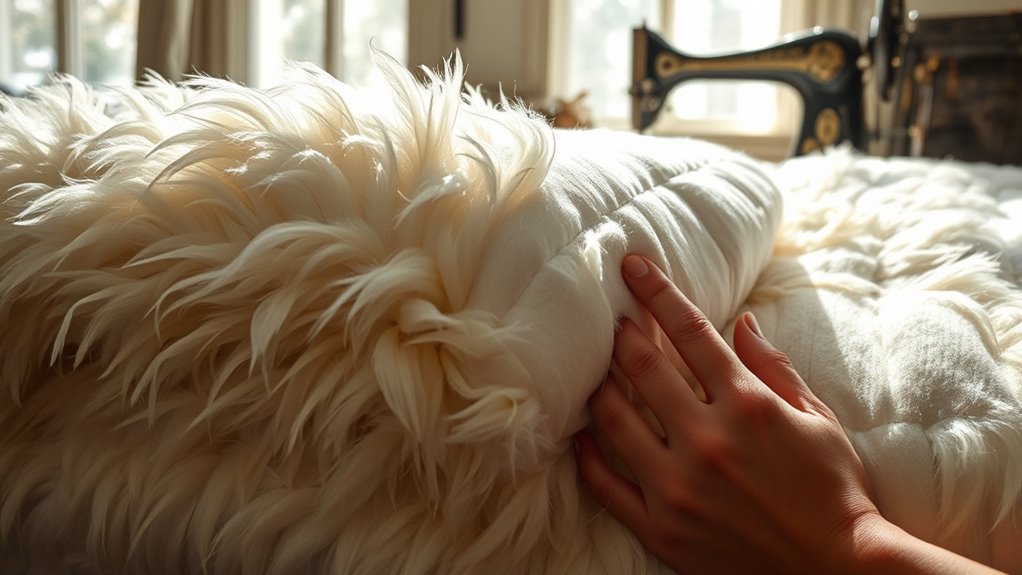
Although the allure of featherbeds has remained strong, economic factors significantly influence their accessibility and production growth.
Market demand fluctuates with economic conditions, which can cause sharp price increases for down and feather products. Since the supply of feathers is mostly fixed, rising demand—especially from emerging markets like China—adds pressure to prices. This situation can also be seen as a form of featherbedding practices, where the balance of supply and demand creates inefficiencies in the market.
As raw material costs for cotton and down rise, you’ll notice these expenses reflected in retail prices. Economic recoveries often lead to further increases in commodity prices, impacting how manufacturers adapt.
If you’re watching your budget, you might seek alternatives as price sensitivity grows, especially during downturns when product availability can also be affected.
Modern Alternatives: Sustainability in Bedding Choices
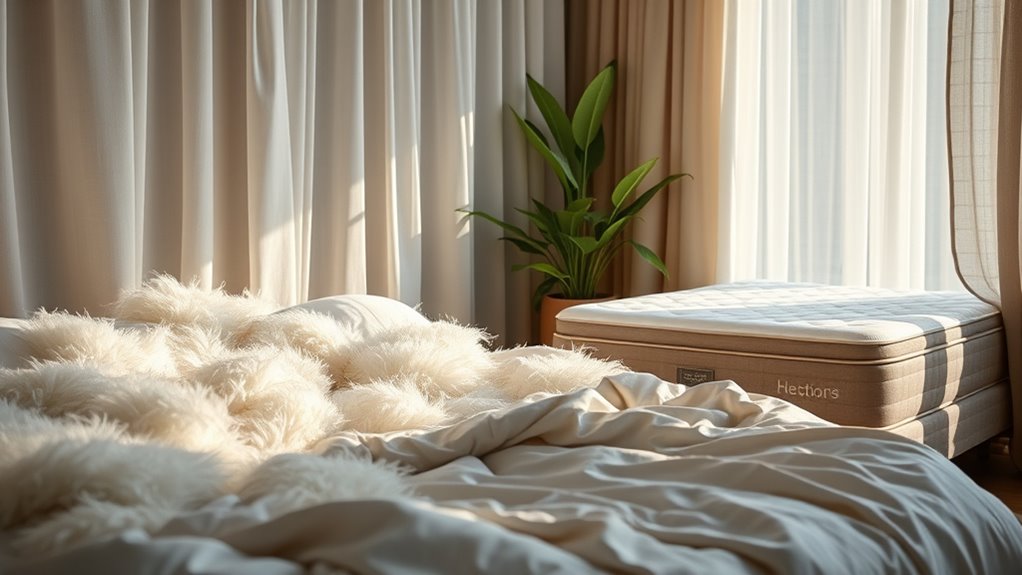
As consumers increasingly prioritize sustainability, modern bedding alternatives have emerged that align with eco-friendly values. You can choose organic cotton, grown without harmful pesticides, or opt for bamboo, which is durable and requires minimal resources. Organic cotton is particularly valued for its soft and breathable qualities, making it a comfortable choice for bedding.
Hemp is another excellent option; it’s fast-growing, drought-tolerant, and naturally resistant to mold. Lyocell, made from wood pulp, boasts a closed-loop process that significantly reduces environmental impact. Additionally, bedding made from recycled materials helps keep waste out of landfills. These sustainable choices not only conserve water and energy but also promote healthier sleep environments free from chemicals.
Frequently Asked Questions
How Do I Properly Clean and Maintain a Featherbed?
To properly clean and maintain your featherbed, air it out every few months to reduce moisture.
Gently vacuum using an upholstery attachment, and for stains, dab with a mild detergent mixture.
Use a protector to guard against dust mites and rotate it regularly.
Avoid compression by not placing heavy objects on it, and fluff it daily.
Finally, ensure it’s completely dry after cleaning to prevent mold growth.
Are Featherbeds Suitable for People With Allergies?
Featherbeds can be suitable for people with allergies if you choose wisely.
Look for hypoallergenic options processed to remove allergens, and use tightly woven encasements to block dust mites. Regular maintenance, like vacuuming and washing covers, is crucial.
Also, consider high-quality feathers from reputable sources and a baffle box construction for durability.
With the right precautions, you can enjoy the comfort of a featherbed without exacerbating your allergies.
What Types of Feathers Are Commonly Used in Featherbeds?
When you’re considering featherbeds, you’ll find that goose feathers are often the top choice for their size and texture.
Duck feathers are also common, providing a softer alternative.
Down feathers stand out as the softest and most insulating option, perfect for warmth.
While chicken feathers are less desirable due to their stiffness, they might still be used in some cases.
Ultimately, the combination of these feathers determines the comfort and quality of your featherbed.
Can Featherbeds Be Used on Adjustable Beds?
Yes, you can use featherbeds on adjustable beds, but there are some considerations.
Since featherbeds are flexible, they can be placed on top of your mattress. However, the weight and bulk might affect how smoothly your adjustable bed operates.
Make sure your adjustable bed can flex well with the added layer. Ultimately, a featherbed can enhance your comfort, but check its compatibility with your specific bed design for the best experience.
How Do I Choose the Right Firmness for a Featherbed?
When you’re choosing the right firmness for your featherbed, consider your sleep preferences.
If you like a firmer feel, opt for a feather-dominant bed; it’ll provide the support you crave.
For those who prefer softness, higher down content is your best bet.
You might also explore double-layered designs for a blend of both.
Conclusion
In the grand tapestry of sleep, featherbeds weave comfort and luxury together, just like the finest silks of a royal court. By embracing their rich history and myriad benefits, you’re not just investing in a good night’s rest; you’re inviting a timeless tradition into your home. As you nestle into the plush embrace of a featherbed, remember that you’re indulging in centuries of craftsmanship and care, ensuring sweet dreams for generations to come.



